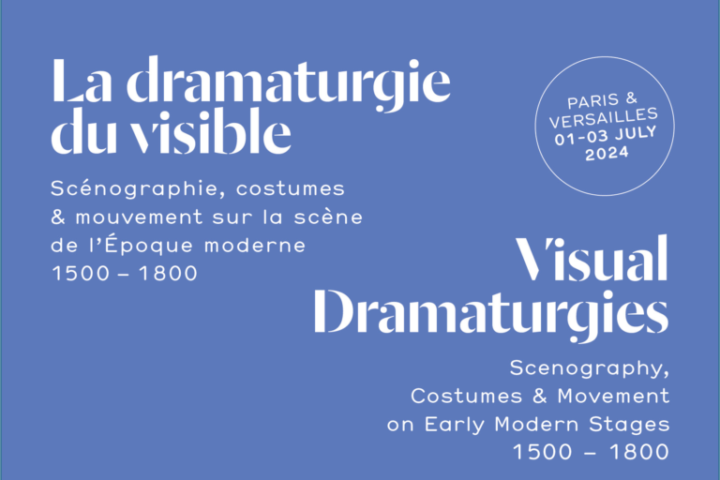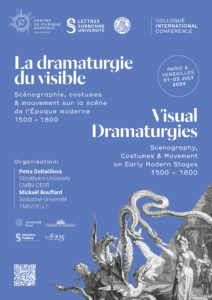June 27, 2024
Visual Dramaturgies, International Conference, PARIS & VERSAILLES 01-03 JULY 2024 Conference

Visual Dramaturgies
Scenography, Costumes & Movement on Early Modern Stages 1500 − 1800
1er, 2 et 3 juillet 2024 / 1-2-3 July 2024
Paris & Versailles
Centre de musique baroque de Versailles & Sorbonne Université (Théâtre Molière Sorbonne)
En partenariat avec / In partnership with
Universität Basel Initiative Théâtre Association pour un centre de recherche sur les Arts du spectacle aux XVIIe et XVIIIe siècles Château de Versailles Forgé
In collaboration with Sorbonne University, the Centre de musique baroque de Versailles is organising an international colloquium devoted to the “dramaturgy of the visible” between the 16th and 18th centuries, bringing together researchers and performing arts practitioners to share research, compare practices and establish convergences.
The term “visual dramaturgies” was coined by the scholar Knut Ove Arntzen to apply to post-modern theatre. However, the concept is equally pertinent to the early modern era, from the emergence of new theatrical forms during the Renaissance to the disruptive reforms of the eighteenth century. Painted scenery not only placed the audience in an atmosphere suitable to the plot, it changed frequently before their very eyes; candlelight intensified the dramatic situation; and the costumes cleverly conveyed the protagonists natures. Movements and gestures also played important dramatic roles, by fashioning characters and weaving relationships among them, enhancing their utterances, and coloring the mood of a scene. Far from being reduced to ornament or simple entertainment, dance could be an essential part of the narrative, helping to build dramatic tension. Consequently, both playwright and librettist sometimes specified visual elements (sets, costumes or attitudes), chosen more for their dramatic potential than for their picturesque effect, proving that these elements were considered inseparable from the writing of the work. This is what Pierre Frantz has aptly called the “dramaturgie du visible”. As these examples suggest, the visual effect in the theatre is produced by subtle interplays of materials and bodies; as a result, therefore the study of their practices is crucial to our understanding of theatre history.
The interest of researchers in the visual – and material – aspects of early modern theatre has increased in the last decade. In addition to the rather developed histories of scenography and dance, an increasing number of publications on the topic of costume, lighting and historical acting have appeared, including more technical studies interested in their production and re-production.
This conference aims to support this trend from a transdisciplinary point of view by bringing together researchers and practitioners interested in Western performing arts (music theatre, dance, drama) of the period between the sixteenth and the eighteenth century in order to share the latest research, compare practices in various periods, countries and theatrical genres, search for convergences and perhaps even debunk some misconceptions.
 ORGANIZING COMMITTEE
ORGANIZING COMMITTEE Petra Dotlačilová (Stockholms universtitet, CESR – CMBV)
Mickaël Bouffard (Sorbonne Université – Théâtre Molière Sorbonne – CELLF)
PROGRAM COMMITTEE
Renaud Bret-Vitoz (Sorbonne Université – CELLF)
Georges Forestier † (Sorbonne Université – CELLF)
Rebecca Harris-Warrick (Cornell University)
Ulla Kallenbach (Universitet i Bergen)
Bénédicte Louvat (Sorbonne Université – CELLF)
Barbara Nestola (CESR – CMBV)
Martina Papiro (Schola Cantorum Basiliensis)
Françoise Rubellin (Université de Nantes)
Magnus Tessing Schneider (Göteborgs universitet)
Hanna Walsdorf (Universität Basel)
Jed Wentz (Universiteit Leiden)
For more information and registration, you can check the website of the event here.
If you want to download the short program, click here.
If you want to download the long program, which includes abstracts, click here.
Note that in both pdf documents, the information are both in english and french, and the abstract are in the conferencist native language.